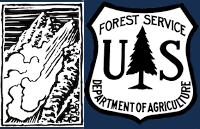As we returned to Frazier Basin from below, we saw five natural avalanches on the southeast-facing wall of the basin. They entrained only the 1 to 2 inches of snow that had fallen during the day. However, they were notable in that they ran 500 to 700 vertical feet. They indicate that the new snow may not bond well to the old snow surface. A crust formed by the recent warm temperatures and sunny skies is the subsurface that snow is falling on. This will become a more significant concern as more snow falls this week. Photo: GNFAC
